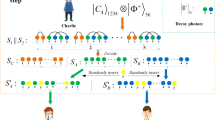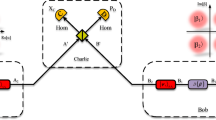Abstract
Cluster state is the basic resource for one-way quantum computation and a valuable resource for establishing quantum network, because it has a flexible and varied composition form. We present measurement-device-independent quantum secret sharing (QSS) and quantum conference (QC) schemes based on continuous variable (CV) four-mode cluster state with different structures. The users of the protocol prepare their own Einstein-Podolsky-Rosen (EPR) states, respectively. One mode of these EPR states is sent to an untrusted relay where a generalized Bell measurement creates different types of CV cluster states among four users, while the other mode is kept at their own station. We show that a shared secret key for QSS and QC schemes is distilled based on the shared quantum correlation among four users. QC and four users QSS are implemented based on the star shape CV cluster state. QSS with three users are implemented based on the linear or square shape CV cluster states. The results show that the secure transmission distance for an asymmetric network, where the transmission distances between the users and relay are different, is longer than that of a symmetric network, where the transmission distances between the users and relay are the same. The presented schemes provide concrete references for establishing quantum network with the CV cluster state.
Similar content being viewed by others
References
Gisin N, Ribordy G, Tittel W, et al. Quantum cryptography. Rev Mod Phys, 2002, 74: 145–195
Weedbrook C, Pirandola S, García-Patrón R, et al. Gaussian quantum information. Rev Mod Phys, 2012, 84: 621–669
Wang S, Chen W, Yin Z Q, et al. Field and long-term demonstration of a wide area quantum key distribution network. Opt Express, 2014, 22: 21739
Wang S, Chen W, Guo J F, et al. 2 GHz clock quantum key distribution over 260 km of standard telecom fiber. Opt Lett, 2012, 37: 1008
Wang S, Yin Z Q, Chau H F, et al. Proof-of-principle experimental realization of a qubit-like qudit-based quantum key distribution scheme. Quantum Sci Technol, 2018, 3: 025006
Yin Z Q, Wang S, Chen W, et al. Improved security bound for the round-robin-differential-phase-shift quantum key distribution. Nat Commun, 2018, 9: 457
Diamanti E, Lo H K, Qi B, et al. Practical challenges in quantum key distribution. Npj Quantum Inf, 2016, 2: 16025
Braunstein S L, Pirandola S. Side-channel-free quantum key distribution. Phys Rev Lett, 2012, 108: 130502
Wang S, Chen W, Yin Z Q, et al. Practical gigahertz quantum key distribution robust against channel disturbance. Opt Lett, 2018, 43: 2030
Wang S, Yin Z Q, Chen W, et al. Experimental demonstration of a quantum key distribution without signal disturbance monitoring. Nat Photon, 2015, 9: 832–836
Acín A, Brunner N, Gisin N, et al. Device-independent security of quantum cryptography against collective attacks. Rhys Rev Lett, 2007, 98: 230501
Wang C, Yin Z Q, Wang S, et al. Measurement-device-independent quantum key distribution robust against environmental disturbances. Optica, 2017, 4: 1016
Lo H K, Curty M, Qi B. Measurement-device-independent quantum key distribution. Phys Rev Lett, 2012, 108: 130503
Lai H, Luo M X, Pieprzyk J, et al. High-rate and high-capacity measurement-device-independent quantum key distribution with Fibonacci matrix coding in free space. Sci China Inf Sci, 2018, 61: 062501
Rubenok A, Slater J A, Chan P, et al. Real-world two-photon interference and proof-of-principle quantum key distribution immune to detector attacks. Phys Rev Lett, 2013, 111: 130501
Ferreira da Silva T, Vitoreti D, Xavier G B, et al. Proof-of-principle demonstration of measurement-device-independent quantum key distribution using polarization qubits. Phys Rev A, 2013, 88: 052303
Tang Z, Liao Z, Xu F, et al. Experimental demonstration of polarization encoding measurement-device-independent quantum key distribution. Phys Rev Lett, 2014, 112: 190503
Yin H L, Chen T Y, Yu Z W, et al. Measurement-device-independent quantum key distribution over a 404 km optical fiber. Phys Rev Lett, 2016, 117: 190501
Braunstein S L, van Loock P. Quantum information with continuous variables. Rev Mod Phys, 2005, 77: 513–577
Li Z, Zhang Y C, Xu F, et al. Continuous-variable measurement-device-independent quantum key distribution. Phys Rev A, 2014, 89: 052301
Zhang Y C, Li Z, Yu S, et al. Continuous-variable measurement-device-independent quantum key distribution using squeezed states. Phys Rev A, 2014, 90: 052325
Grosshans F, Cerf N J, Wenger J, et al. Virtual entanglement and reconciliation protocols for quantum cryptography with continuous variables. Quantum Inf Comput, 2003, 3: 535–552
Pirandola S, Ottaviani C, Spedalieri G, et al. High-rate measurement-device-independent quantum cryptography. Nat Photon, 2015, 9: 397–402
Cleve R, Gottesman D, Lo H K. How to share a quantum secret. Phys Rev Lett, 1999, 83: 648–651
Hillery M, Bužek V, Berthiaume A. Quantum secret sharing. Phys Rev A, 1999, 59: 1829–1834
Gottesman D. Theory of quantum secret sharing. Phys Rev A, 2000, 61: 042311
Dou Z, Xu G, Chen X B, et al. A secure rational quantum state sharing protocol. Sci China Inf Sci, 2018, 61: 022501
Zhao Y, Fung C H F, Qi B, et al. Quantum hacking: experimental demonstration of time-shift attack against practical quantum-key-distribution systems. Phys Rev A, 2008, 78: 042333
van Loock P, Braunstein S L. Multipartite entanglement for continuous variables: a quantum teleportation network. Rhys Rev Lett, 2000, 84: 3482–3485
Zhang J, Braunstein S L. Continuous-variable Gaussian analog of cluster states. Phys Rev A, 2006, 73: 032318
Briegel H J, Raussendorf R. Persistent entanglement in arrays of interacting particles. Phys Rev Lett, 2001, 86: 910–913
van Loock P, Weedbrook C, Gu M. Building Gaussian cluster states by linear optics. Phys Rev A, 2007, 76: 032321
Lv S, Jing J. Generation of quadripartite entanglement from cascaded four-wave-mixing processes. Phys Rev A, 2017, 96: 043873
Wang H, Zheng Z, Wang Y, et al. Generation of tripartite entanglement from cascaded four-wave mixing processes. Opt Express, 2016, 24: 23459
Su X, Zhao Y, Hao S, et al. Experimental preparation of eight-partite cluster state for photonic qumodes. Opt Lett, 2012, 37: 5178
Chen M, Menicucci N C, Pfister O. Experimental realization of multipartite entanglement of 60 modes of a quantum optical frequency comb. Phys Rev Lett, 2014, 112: 120505
Yokoyama S, Ukai R, Armstrong S C, et al. Ultra-large-scale continuous-variable cluster states multiplexed in the time domain. Nat Photon, 2013, 7: 982–986
Raussendorf R, Briegel H J. A one-way quantum computer. Phys Rev Lett, 2001, 86: 5188–5191
Walther P, Resch K J, Rudolph T, et al. Experimental one-way quantum computing. Nature, 2005, 434: 169–176
Menicucci N C, van Loock P, Gu M, et al. Universal quantum computation with continuous-variable cluster states. Rhys Rev Lett, 2006, 97: 110501
Gu M, Weedbrook C, Menicucci N C, et al. Quantum computing with continuous-variable clusters. Phys Rev A, 2009, 79: 062318
Loock P. Examples of Gaussian cluster computation. J Opt Soc Am B, 2007, 24: 340–346
Wang Y, Su X, Shen H, et al. Toward demonstrating controlled-X operation based on continuous-variable four-partite cluster states and quantum teleporters. Phys Rev A, 2010, 81: 022311
Ukai R, Iwata N, Shimokawa Y, et al. Demonstration of unconditional one-way quantum computations for continuous variables. Phys Rev Lett, 2011, 106: 240504
Su X, Hao S, Deng X, et al. Gate sequence for continuous variable one-way quantum computation. Nat Commun, 2013, 4: 2828
Wang L, Lv S, Jing J. Quantum steering in cascaded four-wave mixing processes. Opt Express, 2017, 25: 17457
Lau H K, Weedbrook C. Quantum secret sharing with continuous-variable cluster states. Phys Rev A, 2013, 88: 042313
Deng X, Xiang Y, Tian C, et al. Demonstration of monogamy relations for einstein-podolsky-rosen steering in gaussian cluster states. Phys Rev Lett, 2017, 118: 230501
Wu Y, Zhou J, Gong X, et al. Continuous-variable measurement-device-independent multipartite quantum communication. Phys Rev A, 2016, 93: 022325
Ottaviani C, Lupo C, Laurenza R, et al. High-rate secure quantum conferencing. 2017. ArXiv: 1709.06988
Zhang J. Graphical description of local Gaussian operations for continuous-variable weighted graph states. Phys Rev A, 2008, 78: 052307
Su X, Tan A, Jia X, et al. Experimental preparation of quadripartite cluster and Greenberger-Horne-Zeilinger entangled states for continuous variables. Phys Rev Lett, 2007, 98: 070502
Yukawa M, Ukai R, van Loock P, et al. Experimental generation of four-mode continuous-variable cluster states. Phys Rev A, 2008, 78: 012301
Usenko V C, Grosshans F. Unidimensional continuous-variable quantum key distribution. Phys Rev A, 2015, 92: 062337
Wang X, Liu W, Wang P, et al. Experimental study on all-fiber-based unidimensional continuous-variable quantum key distribution. Phys Rev A, 2017, 95: 062330
Beimel A. Secret-sharing schemes: a survey. In: Proceedings of the 3rd International Conference on Coding and Cryptology (IWCC’11), Heidelberg, 2011. 11–46
Goyal V, Kumar A. Non-malleable secret sharing. In: Proceedings of the 50th Annual ACM SIGACT Symposium on Theory of Computing, New York, 2018. 685–698
Lance A M, Symul T, Bowen W P, et al. Continuous variable (2, 3) threshold quantum secret sharing schemes. New J Phys, 2003, 5: 4
Adesso G, Illuminati F. Entanglement in continuous-variable systems: recent advances and current perspectives. J Phys A-Math Theor, 2007, 40: 7821–7880
Horodecki M, Horodecki P, Horodecki R. Separability of mixed states: necessary and sufficient conditions. Phys Lett A, 1996, 223: 1–8
Simon R. Peres-Horodecki separability criterion for continuous variable systems. Phys Rev Lett, 2000, 84: 2726–2729
Acknowledgements
This work was supported by National Natural Science Foundation of China (Grant Nos. 11504024, 11834010, 61602045, 11522433, 61502041, 61602046), National Key Research and Development Program of China (Grant No. 2016YFA0302600, 2018YFA0306404, 2016YFA0301402), and Program of Youth Sanjin Scholar.
Author information
Authors and Affiliations
Corresponding authors
Rights and permissions
About this article
Cite this article
Wang, Y., Tian, C., Su, Q. et al. Measurement-device-independent quantum secret sharing and quantum conference based on Gaussian cluster state. Sci. China Inf. Sci. 62, 72501 (2019). https://doi.org/10.1007/s11432-018-9705-x
Received:
Revised:
Accepted:
Published:
DOI: https://doi.org/10.1007/s11432-018-9705-x




